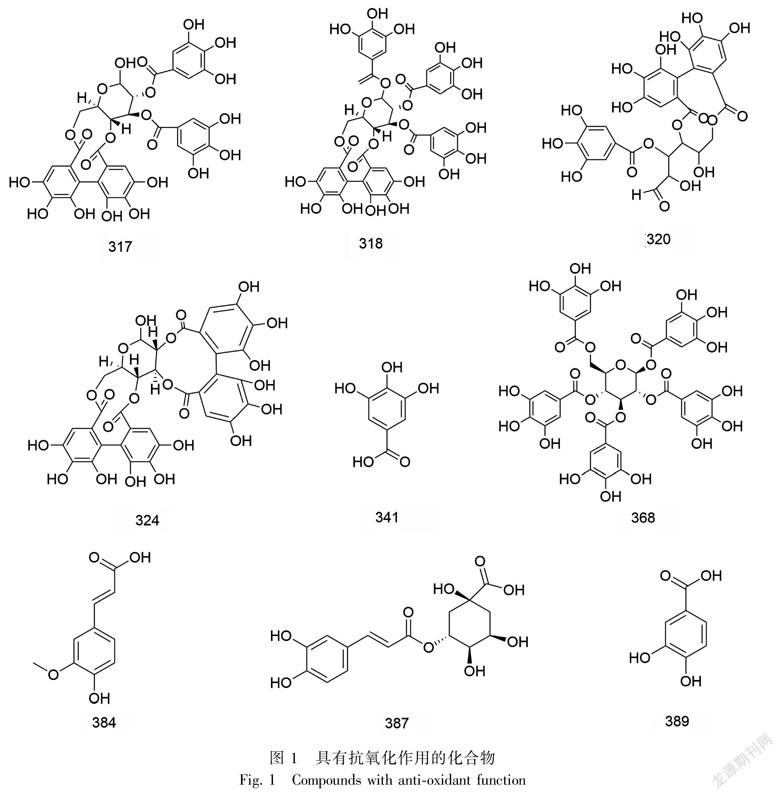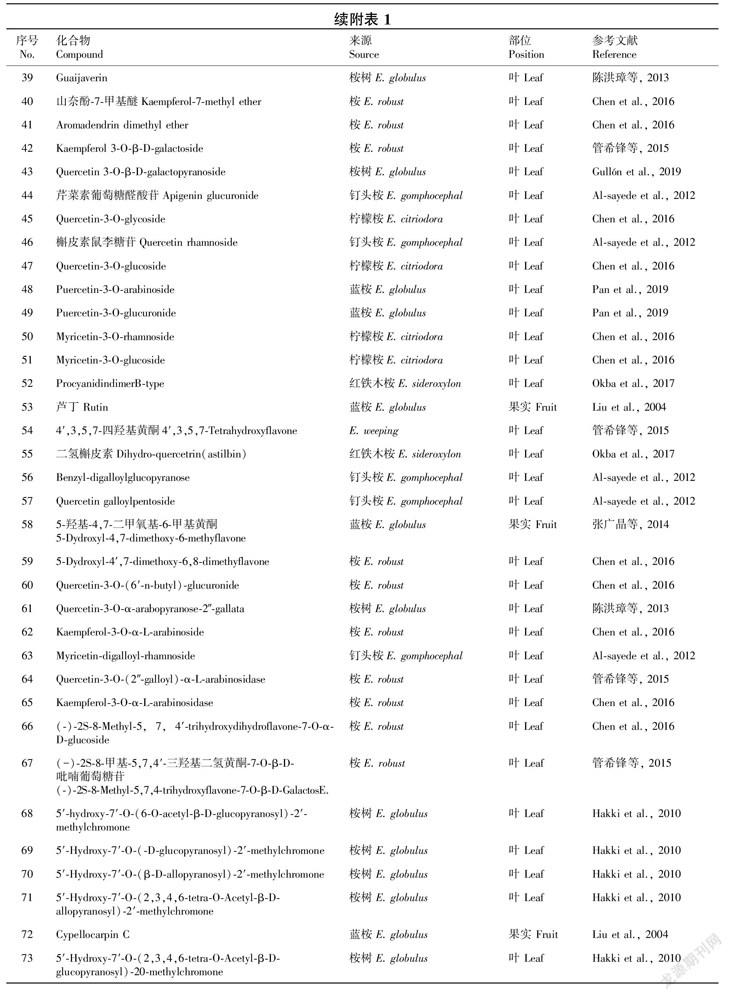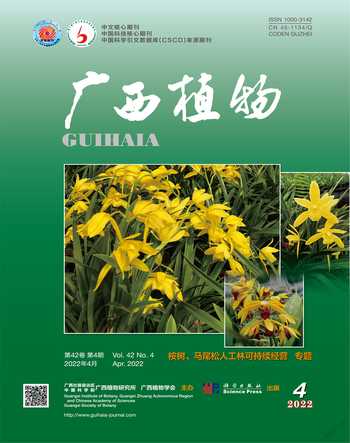桉属植物非挥发性化学成分和药理活性研究进展
黄丽平 周中流 伍影瑶 李春燕 张灿龙 薛中峰



摘要: 桉屬(Eucalyptus L. Herit)是桃金娘科(Myrtaceae)的大属,该属约600余种,主要分布于世界各地热带亚热带地区。我国引入品种较多,主要分布于华南地区,其中广东和广西为桉树的主要种植基地。桉属植物具有较多的工业价值,其木材、叶、果实等是化学工业、香料、医药领域的重要原料,可用作开发高性能桉木重组材、竹桉复合材料、造浆与造纸等。桉属植物作为民间药材被使用,具有抑菌消炎、疏风解热、防腐止痒等功效,其药理研究表明,桉属植物具有良好的抗氧化、抗炎、抗菌、抗病毒、抗肿瘤、抗心血管疾病等药理活性。该研究通过查阅近三十年桉属植物相关的国内外文献报道,对桉属植物不同部位的421个非挥发性化学成分及其药理活性等进行了较详细的分类阐述,其中黄酮类化合物共73个、有机酸化合物共61个、萜类化合物共45个、多酚类化合物共229个、脂肪醇类化合物共13个,药理活性多集中在抗氧化、抗菌、抗病毒、抗肿瘤等,但相关机制仍需进一步阐明。该文重点关注桉属植物的药用部位,充分发掘其药用价值,开展临床转化和新药研究工作,为今后桉属植物的进一步研究、开发和利用提供科学依据。
关键词: 桉属植物, 非挥发性化学成分, 结构分类, 药理活性, 研究进展
中图分类号: Q946文献标识码: A文章编号: 1000-3142(2022)04-0531-12
Research progress of non-volatile chemical components
from Eucalyptus genus plants and their
pharmacological activities
HUANG Liping ZHOU Zhongliu WU Yingyao LI Chunyan
ZHANG Canlong XUE Zhongfeng
( 1. Lingnan Normal University, Zhanjiang 524048, Guangdong, China;
2. Western Guangdong Characteristic Biology and Medicine Englineering
and Research Center, Zhanjiang 524048, Guangdong, China;
3. Guangxi University of Chinese Medicine, Nanning 530220, China )
Abstract: Eucalyptus L. Herit is a large genus of Myrtaceae with more than 600 species, native to Australia and some of its northern islands and mainly distributed in tropical and subtropical regions of the world. Eucalyptus has the characteristics of fast growth, high yield, short rotation period and so on. It is an excellent pulp material with remarkable economic benefits. There are many introduced species in China, mainly distributed in South China. Nearly 80 species have been introduced into China since 1890, and are widely distributed in Guangdong, Guangxi, Guizhou, Sichuan, Yunnan, Jiangxi and other places. At present, China has become one of the countries with the largest area of Eucalyptus plants in the world and is also the largest exporter of Eucalyptus oil. Eucalyptus has a lot of industrial value. Its wood, leaves and fruits are important raw materials in chemical industry, fragrance and medicine fields. They can be used for developing high performance Eucalyptus recombination material, bamboo Eucalyptus composite material, pulp and paper-making, etc. Eucalyptus plants are used as folk medicine, with anti-bacterial and anti-inflammatory, wind-relieving and anti-pyretic, anti-corrosion and anti-pruritic effects. As a traditional medicine, Australian aborigines are the first to use Eucalyptus for the treatment of fever and bronchial diseases; in China, the leaves of E. globulus, E. robusta, E. exserta, E. tereticornis, E. citriodora are often used to treat influenza, dysentery, eczema, and injuries for a long time. Pharmacological studies show that Eucalyptus plants have good anti-oxidant, anti-inflammatory, anti-bacterial, anti-viral, anti-tumor, anti-cardiovascular diseases and other pharmacological activities. In this study, 421 non-volatile chemical constituents from different parts of Eucalyptus and their pharmacological activities are classified and described in detail by referring to the domestic and foreign literatures related to Eucalyptus in recent 30 years. There are 73 flavonoids, 61 organic acids, 45 terpenoids, 229 polyphenols and 13 fatty alcohols. Most of the pharmacological activities are anti-oxidant, anti-bacterial, anti-viral and anti-tumor, but the related mechanisms still need to be further elucidated. This study focuses on the medicinal parts of Eucalyptus, fully explores their medicinal value, and carries out clinical transformation and new drug research, which provides scientific basis for further research, development and utilization of Eucalyptus in the future.
Key words: Eucalyptus genus plants, non-volatile chemical components, structure classification, pharmacological activity, research progress
桉属(Eucalyptus L. Herit),是桃金娘科(Myrtaceae)的大属,广泛种植于澳大利亚、印度尼西亚和马布亚新几里亚,常统称为桉树。其功能多样化,在生态方面可蓄水保土、固碳释氧、积累营养物质和净化环境;在药理作用方面,桉属植物长期以来作为民间药被使用,广泛应用于流行性感冒、痢疾、湿疹、跌打损伤等。中国引种桉树将近100年的历史,约80种,主要分布在福建、广东、广西、云南和四川等地,主要树种有细叶桉、赤桉、柠檬桉、窿缘桉、大叶桉、斜脉胶桉、蓝桉和直杆蓝桉等。桉属植物生长迅速,适应性广,产量高,材质优良,是化学工业、香料、医药领域的重要原料。随着人们对健康的标准日益提高,均向往绿色天然且安全低毒的药物来达到治疗疾病的目的。
目前,关于桉属植物的研究多集中在桉叶的挥发油部位,其挥发油的生物活性物质非常丰富,具有抗肿瘤、抗糖尿病、抗氧化、驱虫、抗菌等活性。国内外学者研究发现桉属植物中非挥发性化合物主要含有黄酮、多酚、萜类和有机酸等,具有抗氧化、抗炎、抗菌、抗病毒、抗肿瘤和抗心血管疾病等药理活性(Chattopadhyay et al., 2002; 陈斌,2002; 唐伟军等,2006; Achiwa et al., 2007;Steinkamp-fenske et al., 2007; Solmaz et al., 2014)。但目前对桉属植物非挥发性成分总结不够全面,化合物结构及其对应的生物活性缺乏系统的归纳总结。本研究依托Web of Science,PubMed和中国知网等数据库检索网站,整理了近30年以来有关桉属植物非挥发性成分的国内外研究论文进行分析,采用罗列、对比、总结归纳等方法,拟探讨以下问题:(1)桉属植物非挥发性成分的分类;(2)桉属植物非挥发性成分的来源;(3)桉属植物非挥发性成分的药理活性和相关机制。本文旨在对其非挥发性化学成分的分类、来源、结构、生物活性等方面进行整理和归纳,以期为桉属植物的深入研究与开发提供参考。
1化学成分
1.1 黄酮类化合物
黄酮类化合物是指两个苯环通过三个碳原子相互连接而成的一系列化合物,即具有C6-C3-C6结构的化合物。国内外学者从桉属植物中分离得到73个黄酮类化合物(附表1),主要包括黄酮和黄酮醇类、二氢黄酮和二氢黄酮醇类、异黄酮类和黄烷醇类。黄酮类化合物数量达62个,主要分布于叶中。
1.2 有机酸类化合物
有机酸是一种含有羧基的酸性有机化合物,结构分为脂肪酸和芳香酸。国内外学者在桉属植物中鉴定了61个有机酸类化合物(附表2),主要有二元羧酸、羟基酸、高级饱和脂肪酸和不饱和脂肪酸。主要分布在叶和茎中的桉属有机酸类化合物数量分别为28和19个。
1.3 萜类化合物
萜类是异戊二烯的聚合体及其衍生物,其骨架一般以5个碳为基本单位。文献报道了桉属植物含42个三萜和3个非挥发性二萜类化合物(附表3和附表4)。桉属非挥发性萜类化合物的结构骨架主要为二萜和三萜,其中二萜类化合物具有直链和单环的结构特征。此外,三萜类化合物主要为五环三萜,结构骨架可分为乌苏烷型、齐墩果烷型和羽扇豆烷型。桉属萜类化合物数量为31个,主要分布在树皮中。
1.4 多酚类化合物
1.4.1 间苯三酚桉属植物中报道了113个间苯三酚类化合物(附表5),基本骨架为1, 3, 5-三羟基苯。间苯三酚类化合物具有明显的结构特征:R1常与邻位的酚羟基结合,结合的基团多数为单萜、倍半萜及二萜类结构片段,形成多环状化合物;R2和R3一般为醛基、甲基、甲氧基、甲基丁酮等。桉属间苯三酚化合物数量达76个,主要分布在其叶中。
1.4.2 鞣质鞣质是一类结构较为复杂的多元酚类化合物,主要由没食子酸及其衍生物构成。桉属植物中已发现82个鞣质(附表6),结构骨架主要为水解鞣质和缩合鞣质。主要分布在其叶和树皮中的桉属鞣质化合物数量分别为58个和15个。
1.4.3 酚酸类研究发现桉属植物含34个酚酸化合物(附表7),结构骨架主要为苯甲酸类、苯烯丙酸、苯丙酸。其中,苯甲酸类可分为单羟基苯甲酸类,双羟基苯甲酸类和三羟基苯甲酸类。桉属酚酸类化合物数量达28个,主要分布在叶中。
1.5 脂肪醇类
从桉属植物中鉴定了13个脂肪醇化合物(附表8),结构骨架主要为直链高级脂肪醇类,碳链含有8~29个碳原子,是合成醇系表面活性劑的主要原料。桉属脂肪醇类化合物数量为11个,主要分布在叶中。
2药理活性
2.1 抗氧化活性
桉属植物E. globules 50%乙醇提取物具有清除DPPH自由基活性,最大清除率为65%,其作用机制通过抑制基质金属蛋白酶(MMPs)和白介素-6(IL-6)的表达,增加转化生长因子-β1(TGF-β1)和1型胶原蛋白的表达,调节TGF-β/Smad信号传导通路,减少皱纹的形成和防止皮肤干燥(Park et al., 2018)。
多酚类化合物317、318、320、324、368和387(图1)具有显著的抗氧化活性,可防止人肝癌细胞氧化及对DPPH和ABTS+两种自由基均具有较强的清除活性,IC50范围为41.4~538.7 μm。多酚类化合物352抗氧化活性最强,IC50为41.4 μm,其结构由一个单糖基连接5个没食子酸,形成含多个没食子酸的水解鞣质类化合物,其抗氧化活性与没食子酸密切相关(谢晓艳等,2011; 肖苏尧等,2012)。
酚酸类化合物341、384和389具有单苯环类母核,结构含酚羟基和羧基,抗氧化能力强。化合物341对DPPH、NO和羟自由基清除率及抑制脂质过氧化的能力强于维生素C(王艳芳等,2005;Ma et al., 2010b),通过调节MMP和TGF-β1表达保护皮肤。化合物368具有保护人脐静脉内皮细胞(HUVEC)免受辐射诱导的氧化应激损伤的作用,可能机制是通过调节PI3K和ERK信号通路,诱导Nrf2活化,增加细胞内谷胱甘肽(GSH)和烟酰胺腺嘌呤二核苷酸磷酸(NADPH)含量,进而保护HUVEC免受辐射诱导的氧化应激损伤(Ma et al., 2010a)。化合物389通过JNK介导的磷酸化激活Nrf2,增强小鼠巨噬细胞的谷胱甘肽过氧化物酶(GPx)和谷胱甘肽还原酶(GR)的表达,从而提高巨噬细胞抗氧化能力(Ma et al., 2010b)。
此外,三萜类化合物152增加氧化应激敏感性转录因子Nrf2和MAP激酶的表达来保护人肝细胞,使其免受叔丁基过氧化氢(t-BHP)诱导的细胞毒性;还具有消除ROS,抑制脂质过氧化和强化抗氧化防御系统的功能(Ma et al., 2010a)。
2.2 抗炎活性
蓝桉乙醇提取物具有明显的抗炎镇痛作用,可显著减轻小鼠耳廓肿胀和提高毛细血管通透性,明显抑制大鼠棉球肉芽肿和阻止组胺从RBL-2H3细胞中的释放,从而达到抗炎及治疗哮喘的效果(何耀松等,2007; 唐云等,2015)。另外,酚酸类化合物384通过阻断 JNK信号通路,抑制辐射诱导的U937对HUVEC的粘附,阻止细胞间黏附分子-1(ICAM-1)和血管细胞黏附分子-1(VCAM-1)的表达,发挥抗炎作用(Ma et al., 2010b)。
2.3 抗菌作用
桉属植物中具有抗菌活性的三萜类化合物主要为乌苏烷型和羽扇豆烷型(图2)。Chattopadhyay等(2002)发现熊果酸(151)具有抗菌活性强、广谱等特点,对金黄色葡萄球菌、腐生葡萄球菌、粪链球菌等细菌均表现出良好的抑制作用,最低抑菌浓度(MIC)为0.128~2 mg·mL-1。陈斌等(2002)报道了白桦酸(156)和2α-羟基熊果酸(153)对金黄色葡萄球菌和大肠杆菌表现出较强的抑菌活性,MIC为12.5~50 μg·mL-1。熊果酸和2α-羟基熊果酸均有良好的抗菌活性,且羟基取代物抗菌活性有增大趋势。另外,酚类化合物间苯三酚化合物272和273对葡萄球菌和枯草杆菌具有良好的抑制作用,半数抑制浓度(IC50)分别为3.9和7.8 μg·mL-1,且α构型活性强于β构型。大果桉醛类化合物对革兰阳性菌有明显抑制活性,其中化合物217、218、219、220、224和233均具有较强的抗龋齿和牙周病菌活性,MIC为0.39~100 μg·mL-1,且抗菌活性强于抗菌剂百里酚;大果桉醛A-G(217-223)对金黄色葡萄球菌、枯草芽孢杆菌、藤黄微球菌和包皮垢分支杆菌的IC50均处于0.78~3.13 μg·mL-1范围;化合物233对变形链球菌和茸毛链球菌均表现出良好的抑制作用,MIC分别为12.5和6.25 μg·mL-1(Osawa et al.,1996; 付文卫等,2003; 刘玉明,2004; Huang et al.,2014)。桉属植物中以大果桉醛类为代表的间苯三酚类化合物具有抗菌谱广、活性强等特点,有望从中发现新的天然抗菌先导化合物。
2.4 抗病毒作用
桉属植物提取物对甲型流感病毒、人类疱疹病毒和乙肝病毒均有一定的抑制作用。Wang等(2005)以甲Ⅰ型流感病毒感染的小鼠为研究对象,芦丁(53)表现出明显的抗甲Ⅰ型流感病毒作用。Tang等(2015)报道了间苯三酚207、202和220(图3)具有显著的抗人类疱疹病毒作用。三萜类化合物156、151和153具有较强的抗乙肝病毒作用,对乙肝表面抗原(HBsAg)的抑制率分别为47.0%、39.9%和30.2%,对乙型肝炎E抗原(HBeAg)的抑制率分别为12.3%、23.6%和13.96%(陈斌,2002)。
2.5 抗肿瘤作用
2.5.1 抗白血病白血病是血液系统恶性肿瘤的一种,Benyahia等(2004)研究发现黄酮类化合物13和14(图4)可抑制人早幼粒细胞白血病细胞HL-60的存活和增殖,化合物13(IC50= 1.7±0.1 μmol·L-1)的抑制作用强于14(IC50=7.4±2.3 μmol·L-1),可能原因是B环对位甲氧基被羟基取代,导致活性降低。半胱天冬酶(caspases)在细胞凋亡的过程中起关键性作用,caspase-8和caspase-3的表达在各种癌症中显著下降。化合物13和14均通过活化caspase-8,激活caspase-3,释放细胞色素c,裂解聚腺苷二磷酸核糖聚合酶-1(PARP-1),使DNA无法修复,最终导致肿瘤细胞凋亡。
Solmaz等(2014)研究表明芹菜素(9)对伊马替尼敏感和耐药的慢性髓性白血病具有治疗潜力,通过磷酸化热休克蛋白27(Hsp27)、活化半胱天冬酶和促进HL-60细胞中的线粒体去极化,从而诱导肿瘤细胞凋亡;另外,还通过降低线粒体膜电位(MMP)和激活caspase-3,诱导K562和K562/IMA3两种细胞凋亡,高劑量条件下可使K562细胞周期停滞在G2/M期。
2.5.2 抗消化系统肿瘤桉属植物中黄酮类化合物槲皮素(12)、异槲皮苷(18)、木犀草素(23)等对消化系统肿瘤具有很好的抑制作用(图5)。Huang等(2014)研究发现,化合物18对肝癌具有很强的抑制作用,其分子机制可能与丝裂原活化蛋白激酶(MAPK)和蛋白激酶C(PKC)信号通路密切相关。Sabry等(2021)研究发现,桉树水溶性树脂多酚对肝癌也具有抑制作用,其机制与抑制MMP-9和TEF-β的基因表达相关。Solmaz等(2014)发现异槲皮苷通过激活caspase-3发挥抑制ERK和p38-MAPK蛋白磷酸化和促进应激活化蛋白激酶(JNK)的磷酸化,使肝癌细胞被阻滞在G1期。化合物23可抑制人胃癌BGC-823细胞裸鼠移植瘤,且抑制作用强于阳性对照药5-氟尿嘧啶。化合物12通过激活5′-AMP活化蛋白激酶(AMPK)/p38-MAPK通路,降低线粒体膜电位,使AMPKα1磷酸化,抑制细胞的生长和增殖,从而诱导HT-29结肠癌细胞p53突变细胞凋亡。此外,还可通过调节AMPK/COX-2通路,激活AMPK磷酸化,抑制COX-2、PGs表达和血管生成,使细胞周期停滞在亚G1期,最终诱导HT-29结肠癌细胞凋亡(Lee et al., 2009)。
2.5.3 抗乳腺癌、子宫癌槲皮素(12)激活了MCF-7乳腺癌细胞,激活AMPKα1/ASK1/p38信号通路诱导乳腺癌细胞凋亡(Lee et al., 2010)。木犀草素(23)抑制MCF-7细胞增殖、Bcl-2和基质金属蛋白酶2(MMP-2)蛋白表达,从而达到抗乳腺癌的效果(姜英等,2013)。Achiwa等(2007)发现熊果酸(151)具有抗子宫内膜癌作用,主要通过抑制子宫内膜癌细胞系SNG-Ⅱ和低分化的HEC108细胞系中的PI3K-Akt途径和MAPK-P44/42途径,降低子宫内膜癌SNG-Ⅱ细胞中的PI3K水平,从而杀死肿瘤细胞。
2.5.4 广谱抗肿瘤作用蓝桉总三萜具有广谱抑制肿瘤细胞生长作用,对人肺癌细胞A-549,人胃癌细胞AGS、SGC-7901,人结肠癌细胞Caco-2、LS-174T等各种类型癌细胞均有抑制作用,尤其是对小鼠黑色素瘤 B16,抑制率可达到55.6%(陈斌,2002; 刘玉明,2004)。刘玉明等(2004)发现苯三酚类化合物218对人肝、胃、食管等癌细胞具有显著的抑制活性。另外,化合物211、215和216(图6)对人肝癌细胞Huh-7、人外周血白血病T细胞Jurkat、人胃癌细胞BGC-823和浆细胞骨髓瘤细胞KE-97均具有显著的抑制活性(唐伟等,2015)。化合物185和207可通过抑制由TPA诱导的细胞周期减少肿瘤形成(张广晶等,2014)。Solmaz等(2014)发现黄酮类化合物芹菜素(9)也可诱导多种肿瘤细胞凋亡,包括乳腺癌、宫颈癌、肺癌、卵巢癌、前列腺癌和肝癌,机制与PI3K(磷脂酰肌醇3-激酶)/Akt(蛋白激酶B)通路密切相关。
2.6 抗心血管疾病
动脉硬化和血栓性疾病的发病可能与高浓度的纤溶酶原激活剂抑制剂1(plasminogen activator inhibitor type-1,PAI-1)有关,特异性抑制PAI-1可增加纤维蛋白溶解,从而达到治疗动脉硬化和血栓性疾病作用。桉属植物间苯三酚类272-274、199、276和204(图7)具有较强的抑制PAI-1活性,其IC50值分别为3.3、5.3、4.7、138、700和152 μmol·L-1(付文卫等,2003; 李伟,2015)。三萜类化合物也具有保护心脑血管的作用,ursolic acid(151)可通过抑制活性氧的产生,增加NO的表达,发挥保护血管内皮功能。Betulinic acid(156)通过激活 PI3K和 ERK/Nrf2通路,上调血管平滑肌细胞(VSMC)中血管平滑肌細胞血红素氧合酶-1(HO-1)的表达,表现出抗动脉粥样硬化功能(Steinkamp-fenske et al., 2007; Feng et al., 2011)。
2.7 其他作用
桉属植物中的间苯三酚类化合物具有较强的酶抑制活性(图8)。化合物212具有抑制P450酶活性,其IC50值为38.8 μmol·mL-1(王冀,2012)。217-221能够抑制HIV 逆转录酶,其IC50值分别为 10、5.3、8.4、12和8.1 μmol·L-1(李伟, 2015)。217、218、220、221、272和273等具有抑制醛糖还原酶活性,其中272和273对醛糖还原酶的IC50值分别为1.25 和2.47 μmol·L-1(Elaissi et al., 2011)。217-220、224-226和233在浓度为100 μg·mL-1时均具有明显的抑制葡萄糖基转移酶活性,抑制作用强于阳性对照药(付文卫等,2003)。间苯三酚类化合物还表现出抗附着及拒食和抑制受精卵发育的药理作用,可抗驱逐蓝贝类Mytilus edulis galloprovincialis的附着(付文卫等,2003; 王冀,2012)。此外,桉属黄酮类化合物可应用于农作物增产(宋永芳等,1984)。
3讨论与展望
目前,桉属植物非挥发性化学成分的提取分离较系统和全面,从根、茎、叶、树皮和果实等中分离报道了421个非挥发性化合物,其中主要为黄酮类、有机酸类、萜类、多酚类和脂肪醇类成分,表现出较好的抗氧化、抗病毒、抗肿瘤等药理活性,但相关的作用机制尚浅,仍需进一步阐明。具体如下:(1) 抗氧化活性多集中在乙醇提取物、多酚类化合物、简单酚酸类化合物和三萜类化合物,机制可能与TGF-β/Smad、PI3K/ERK/Nrf2等通路相关。(2) 蓝桉乙醇提取物和酚酸类化合物表现出一定的抗炎镇痛活性,但如何发挥抗炎作用的具体作用靶点和机制仍需详细阐明。(3)抗菌作用主要集中在三萜类化合物和酚类化合物间苯三酚,但抑菌机制仍未明确。(4)桉属植物提取物的抗病毒作用较强,尤其对甲型流感病毒、人类疱疹病毒和乙肝病毒均有一定的抑制作用,但相关机制尚未完全清晰。(5)抗肿瘤作用主要集中在黄酮类化合物(芹菜素,槲皮素,木犀草素等)、蓝桉总三萜化合物、间苯三酚类化合物,对白血病、消化系统肿瘤以及其他癌症效果显著,机制研究深入,值得临床推广。(6)间苯三酚类和三萜类化合物表现出较好的抗动脉粥样硬化保护心脑血管功能,但机制仍不完全阐明。(7)间苯三酚类化合物还表现出有较强的酶抑制活性,如抑制HIV 逆转录酶、醛糖还原酶和葡萄糖基转移酶活性,提示其仍有很大的开发应用价值。
总之,该属植物的提取物具有诸多生物活性,但主要为挥发性成分,对非挥发性成分研究较少。根据目前已有的相关研究可在适宜的地区进行研究和推广,进一步分离提纯其有效成分,研究和阐明其化学结构、药理活性与作用机制,将有助于桉属植物资源的开发和利用。
参考文献:
ABDEL-MOEIN NM, ABDEL-MONIEM EA, MOHAMED DA,et al., 2011. Evaluation of the anti-inflammatory and anti-arthritic effects of some plant extracts [J]. Grasas Aceites, 62(4): 365-374.
ACHIWA Y, HASEGAWA K, UDAGAWA Y, 2007. Regulation of the phosphatidylinositol 3-kinase-akt and the mitogen-activated protein kinase pathways by ursolic acid in human endometrial cancer cells [J]. Biosci Biotechnol Biochem, 71(1): 31-37.
AL-SAYED E, SINGAB A, AYOUB N,et al., 2012. HPLC-PDA-ESI-MS/MS profiling and chemopreventive potential of Eucalyptus gomphocephala DC [J]. Food Chem, 133(3): 1017-1024.
BENOUADAH N, PRANOVICH A, ALIOUCHE D,et al., 2018. Analysis of extractives from Pinus halepensis and Eucalyptus camaldulensis as predominant trees in Algeria [J]. Holzforschung, 72(2): 97-104.
BENYAHIA S, BENAYACHE S, BENAYACHE F, et al., 2004. Isolation from Eucalyptus occidentalis and identification of a new kaempferol derivative that induces apoptosis in human myeloid leukemia cells [J]. J Nat Prod, 67(4): 527-531.
BHUYAN DJ, VUONG QV, BOND DR,et al., 2018. Eucalyptus microcorys leaf extract derived HPLC-fraction reduces the viability of mia paca-2 cells by inducing apoptosis and arresting cell cycle [J]. Biomed Pharmacotherapy, 105: 449-460.
BOULEKBACHE MAKHLOUF L, MEUDEC E, MAZAURIC JP, et al., 2013. Qualitative and semi-quantitative analysis of phenolics in Eucalyptus globulus leaves by high-performance liquid chromatography coupled with diode array detection and electrospray ionisation mass spectrometry [J]. Phytochem Analy, 24(2): 162-170.
CHATTOPADHYAY D, ARUNACHALAM G, MANDAL AB,et al., 2002. Antimicrobial and anti-inflammatory activity of folklore: Mallotus peltatus leaf extract [J]. J Ethnopharmacol, 82(2-3): 229-237.
CHEN B, 2002. Study on a ctive constituents of fruit of Eucalyptus globules [D]. Shanghai: The Second Military Medical University. [陈斌, 2002. 蓝桉果实活性成分的研究 [D]. 上海: 第二军医大学.]
CHEN HZ, HUANG JS, WANG JL,et al., 2015. Total polyphenol and antioxidant activities of ‘Guanglin No.9 eucalyptus leaves from different months [J]. Sci Technol Food Ind, 34(17): 56-59. [陈洪璋, 黄景晟, 王俊亮, 等, 2013. 不同月份“广林9号”桉叶粗提物总酚含量与抗氧化活性研究 [J]. 食品工业科技, 34(17): 56-59.]
CHEN YJ, WANG JJ, OU YW, et al., 2014. Cellular antioxidant activities of polyphenols isolated from Eucalyptus leaves (Eucalyptus grandis×Eucalyptus urophylla GL9) [J]. J Funct Foods, 7: 737-745.
CHEN YQ, LI W, CHEN HZ, et al., 2016. The isolation and purification of compounds from Eucalyptus leaves and their antioxidant activity [J]. Eucalypt Sci Technol, 33(2): 25-32. [陳运娇, 李伟, 陈洪璋, 等, 2016. 桉叶抗氧化物分离纯化及其抗氧化活性的研究 [J]. 桉树科技, 33(2): 25-32.]
DOMINGUES RMA, OLIVEIRA ELG, FREIRE CSR, et al., 2012. Supercritical fluid extraction of Eucalyptus globulus bark — a promising approach for triterpenoid production [J]. Int J Mol Sci, 13(6): 7648-7662.
DOMINGUES RMA, SOUSA GDA, FREIRE CSR,et al., 2010. Eucalyptus globulus biomass residues from pulping industry as a source of high value triterpenic compounds [J]. Ind Crop Prod, 31(1): 65-70.
DOMINGUES RMA, SOUSA GDA, SILVA CM,et al., 2011. High value triterpenic compounds from the outer barks of several Eucalyptus species cultivated in Brazil and in Portugal [J]. Ind Crop Prod, 33(1): 158-164.
ELAISSI A, MEDINI H, SIMMONDS M, et al., 2011. Variation in volatile leaf oils of seven Eucalyptus species harvested from Zerniza Arboreta (Tunisia) [J]. Chem Biodivers, 8(2): 362-372.
FENG J, ZHANG P, CHEN XX, et al., 2011. PI3K and ERK/Nrf2 pathways are involved in oleanolic acid-induced heme oxygenase-1 expression in rat vascular smooth muscle cells [J]. J Cell Biochem, 112(6): 1524-1531.
FU WW, ZHAO CJ, PEI YP,et al., 2003. Chemical constituents and biological activities of Eucalyptus [J]. Drugs Clinic, 18(2): 51-58. [付文卫, 赵春杰, 裴玉萍, 等, 2003. 桉属植物的化学成分与生物活性 [J]. 国外医药(植物药分册), 18(2): 51-58.]
GAO X, 2017. Extraction and analysis of effective components from Eucalyptus [D]. Nanning: Guangxi University. [高璇, 2017. 窿緣桉树有效成分的提取及分析 [D]. 南宁: 广西大学.]
GU ZB, YAN L, XU YX,et al., 2001. Studies on chemical constituents of Eucalyptus camaldulensis var. pendula [J]. Chin Trad Herb Drugs, (4): 12-13. [顾正兵, 闫露, 徐一新, 等, 2001. 垂枝赤桉的化学成分研究 [J]. 中草药, (4): 12-13.]
GUAN XF, GUO QY, HUANG XJ,et al., 2015. A new flavonoid glycoside from leaves of Eucalyptus robusta [J]. Chin J Chin Mat Med, 40(24): 4868-4872. [管希锋, 郭倩仪, 黄晓君, 等, 2015. 大叶桉叶中一个新的黄酮苷 [J]. 中国中药杂志, 40(24): 4868-4872.]
GUIMARES R, BARROS L, CARVALHO AM, et al., 2009. Aromatic plants as a source of important phytochemicals: vitamins, sugars and fatty acids in cistus ladanifer, cupressus lusitanica and Eucalyptus gunnii leaves [J]. Ind Crop Prod, 30(3): 427-430.
GULL?N B, MU?IZ-MOURO A, L?-CHAU TA,et al., 2019. Green approaches for the extraction of antioxidants from Eucalyptus leaves [J]. Ind Crop Prod, 138: 111473.
HAKKI Z, CAO B, HESKES AM,et al., 2010. Synthesis of the monoterpenoid esters cypellocarpin c and cuniloside b and evidence for their widespread occurrence in Eucalyptus [J]. Carbohyd Res, 345(14): 2079-2084.
HE YS, ZHANG JD, 2007. Progress on chemical constituents and pharmacological effects of Eucalyptus [J]. Prog Veter Med, 28(7): 98-101. [何耀松, 张继东, 2007. 桉树化学成分及药理作用研究进展 [J]. 动物医学进展, 28(7): 98-101.]
HUANG BS, 2013.Chemical composition, antimicrobial and antioxidative properties from leaves of Eucalyptus growing in Guangdong [D]. Guangzhou: Guangdong Pharm University. [黄炳生, 2013. 广东桉树叶化学成分及其抗菌抗氧化活性研究 [D]. 广州: 广东药学院.]
HUANG GH, TANG B, TANG K,et al., 2014. Isoquercitrin inhibits the progression of liver cancer in vivo and in vitro via the MAPK signalling pathway [J]. Oncol Rep, 31(5): 2377-2384.
IBRAHIM M, AMBREEN S, HUSSAIN A,et al., 2014. Phytochemical investigation on Eucalyptus globulus Labill [J]. Asian J Chem, 26(4): 1011-1014.
JIANG Y, XIE KP, HUO HN, et al., 2013. Inhibitory effect of luteolin on the angiogenesis of chick chorioallantoic membrane and invasion of breast cancer cells via downregulation of AEG-1 and MMP-2 [J]. Acta Physiol Sin, 65(5): 513-518. [姜英, 谢鲲鹏, 霍洪楠, 等, 2013. 木犀草素下调AEG-1和MMP-2的表达对血管生成和乳腺癌细胞侵袭性的抑制作用 [J]. 生理学报, 65(5): 513-518.]
KAHLA Y, ZOUARI-BOUASSIDA K, REZGUI F,et al., 2017. Efficacy of Eucalyptus cinerea as a source of bioactive compounds for curative biocontrol of crown gall caused by agrobacterium tumefaciens strain B6 [J]. Biomed Res Int, 2017: 9308063.
LEE Y, SONG YP, KIM Y,et al., 2009. AMP kinase/cyclooxygenase-2 pathway regulates proliferation and apoptosis of cancer cells treated with quercetin [J]. Exp Mol Med, 41(3): 201-207.
LEE YK, HWANG JT, KWON DY, et al., 2010. Induction of apoptosis by quercetin is mediated through AMPKα1/ASK1/p38 pathway [J]. Cancer Lett, 292(2): 228-236.
LEI QC, 2017. Study on the bioactivities and active constituents of Eucalyptus globulus leaves [D]. Hangzhou: Zhejiang Gongshang University. [雷啟成, 2017. 蓝桉叶的生物活性及活性成分研究 [D]. 杭州: 浙江工商大学.]
LI JJ, XU HH, 2014. Isolation, structural ldentification and bioactivity of chemical constituents from the bark of Eucalyptus exserta F. Muell [J]. Nat Prod Res Dev, 26(9): 1345-1349. [李晶晶, 徐汉虹, 2014. 窿缘桉树皮化学成分的分离鉴定及其生物活性研究 [J]. 天然产物研究与开发, 26(9): 1345-1349.]
LI W, 2015. Research advances on phloroglucinol derivatives in plants of Eucalyptus L. Heritier [J]. Chin Trad Herb Drugs, 46(23): 3592-3604. [李伟, 2015. 桉属植物中间苯三酚衍生物的研究进展 [J]. 中草药, 46(23): 3592-3604.]
LIANG QS, WEI JX, 1985. Research progress on chemical and physiological active components of Eucalyptus [J]. Eucalypt Sci Technol, (2): 25-46. [梁庆燊, 魏景新, 1985. 桉属植物的化学及其生理活性成分的研究进展 [J]. 桉树科技, (2): 25-46.]
LIU H, FENG MY, YU Q, et al., 2018. Formyl phloroglucinol meroterpenoids from eucalyptus tereticornis and their bioactivities [J]. Tetrahedron, 74(13): 1540-1545.
LIU YM, 2004.Studies on chemical constituents of fruit of Eucalyptus globules and its quality control [D]. Shanghai: The Second Military Medical University. [劉玉明, 2004. 蓝桉果实化学成分及质量控制研究 [D]. 上海: 第二军医大学药物分析学.]
LIU YM, CAI YF, WU YT, et al., 2004. Study on the essential oil from the fruit of Eucalyptus globulus Labill. and E. robusta smith by GC-MS [J]. Chin J Pharm Anal, 24(1): 24-26. [刘玉明, 柴逸峰, 吴玉田, 等, 2004. GC-MS对蓝桉果实及大叶桉果实挥发油成分研究 [J]. 药物分析杂志, 24(1): 24-26.
MA ZC, HONG Q, WANG YG,et al., 2010a. Ferulic acid protects human umbilical vein endothelial cells from radiation induced oxidative stress by phosphatidylinositol 3-kinase and extracellular signal-regulated kinase pathways [J]. Biol Pharm Bull, 33(1): 29-34.
MA ZC, HONG Q, WANG YG,et al., 2010b. Ferulic acid attenuates adhesion molecule expression in gamma-radiated human umbilical vascular endothelial cells [J]. Biol Pharm Bull, 33(5): 752-758.
NIKBAKHT MR, RAHIMI-NASRABADI M, AHMADI F,et al., 2015. The chemical composition and in vitro antifungal activities of essential oils of five Eucalyptus species [J]. J Essent Oil Bear Plant, 18(3): 666-677.
OKBA MM, GEDAILY RAE, ASH RM, 2017. UPLC-PDA-ESI-qTOF-MS profiling and potent anti-HSV-Ⅱ activity of Eucalyptus sideroxylon leaves [J]. J Chromatogr B, 1068-1069: 335-342.
OSAWA K, YASUDA H, MORITA H,et al., 1996. Macrocarpals H, I, and J from the leaves of Eucalyptus globulus [J]. J Nat Prod, 59(9): 823-827.
PAN M, LEI Q, ZANG N,et al., 2019. A strategy based on GC-MS/MS, UPLC-MS/MS and virtual molecular docking for analysis and prediction of bioactive compounds in Eucalyptus globulus leaves [J]. Int J Mol Sci, 20(16): 3875.
PARK B, HWANG E, SEO SA, et al., 2018. Eucalyptus globulus extract protects against UVB-induced photoaging by enhancing collagen synthesis via regulation of TGF-β/Smad signals and attenuation of AP-1 [J]. Arch Biochem Biophys, 637(1): 31-39.
PARREIRA P, SOARES BIG, FREIRE SR,et al., 2017. Eucalyptus spp. outer bark extracts inhibit helicobacter pylori growth: in vitro studies(Article) [J]. Ind Crop Prod, 207-214.
PAVLOVA LV, PLATONOV IA, NIKITCHENKO NV, et al., 2017. Extraction of biologically active compounds from Eucalyptus (Eucalypti viminalis Labill) leaves by subcritical water and water-ethanol mixtures [J]. Russ J Phys Chem B, 11(7): 1129-1143.
PHAM TA, HU XL, HUANG XJ, et al., 2019. Phloroglucinols with immunosuppressive activities from the fruits of Eucalyptus globulus [J]. J Nat Prod, 82(4): 859-869.
PUIG CG, REIGOSA MJ, VALENT?O P,et al., 2018. Unravelling the bioherbicide potential of Eucalyptus globulus Labill: biochemistry and effects of its aqueous extract [J]. PLoS ONE, 13(2): 19-28.
QIN GW, XU RS, 1986. Studies on chemical constituents of Eucalyptus grandis-isolation and identification of phenol B and other components of Eucalyptus grandis [J]. Acta Chim Sin, 44(2): 151-156. [秦國伟, 徐任生, 1986. 大叶桉化学成分的研究-大叶桉酚乙和其它成分的分离和鉴定 [J]. 化学学报, 44(2): 151-156.]
RODRIGUES VH, DE MELO MMR, PORTUGAL I,et al., 2018. Extraction of Eucalyptus leaves using solvents of distinct polarity cluster analysis and extracts characterization [J]. J Supercrit Fluid, 135: 263-274.
SABRY OM, SABRY MO, EI-SONBATY et al., 2021. In-vivo and in-silico studies of Eucalyptus kino polyphenolics: outstanding activity in quenching solid liver tumors through inhibition of MMP-9 and TGF-β gene expression [J]. Nat Prod Res, DOI: 10.1080/14786419.2021.1961254
SHEN ZB, XU JP, 1987. Studies on chemical constituents of Eucalyptus citri leaves (second report)-isolation and identification of flavonoids [J]. Chem Ind For Prod, (2): 29-35. [沈兆邦, 徐建平, 1987. 柠檬桉叶化学成分研究(二报)-黄酮类化合物的分离鉴定 [J]. 林产化学与工业, (2): 29-35.]
SHEN ZB, YU QZ, 1986. Study on chemical constituents of Eucalyptus citri leaves (first report) [J]. Chem Ind For Prod, (3): 30-33. [沈兆邦, 虞启庄, 1986. 柠檬桉叶化学成分研究(一报) [J]. 林产化学与工业, (3): 30-33.]
SILVRIO FO, BARBOSA LCA, FIDNCIO PH,et al., 2011. Evaluation of chemical composition of Eucalyptus wood extracts after different storage times using principal component analysis [J]. J Wood Chem Technol, 31(1): 26-41.
SOLMAZ S, ADAN GOKBULUT A, CINCIN B,et al., 2014. Therapeutic potential of apigenin, a plant flavonoid, for imatinib-sensitive and resistant chronic myeloid leukemia cells [J]. Nutr Cancer, 66(4): 599-612.
SONG YF, WANG BL, YU Q, et al., 1984. Extraction of flavonoids from Eucalyptus leaves and its application in agriculture [J]. Chem Ind For Prod, (2): 19-28. [宋永芳, 王碧兰, 郁青, 等, 1984. 桉树叶中黄酮类的提取及其在农业上的应用 [J]. 林产化学与工业, (2): 19-28.]
STEINKAMP-FENSKE K, BOLLINGER L, LLER NV, et al., 2007. Ursolic acid from the chinese herb danshen (Salvia miltiorrhiza L.) upregulates eNOS and downregulates nox4 expression in human endothelial cells [J]. Atherosclerosis, 195(1): e104-e111.
TANG WJ, ZHOU JF, LI XN, et al., 2006. Study on the chemical components in leaf essential oil of Eucalyptus robusta [J]. J Anal Sci, 22(2): 182-186. [唐伟军, 周菊峰, 李晓宁, 等, 2006. 大叶桉叶挥发油的化学成分研究 [J]. 分析科学学报, 22(2): 182-186.]
TANG Y, LI W, 2015. Research advances on chemical constituents of Eucalyptus globulus and their pharmacological activities [J]. Chin Trad Herb Drugs, 46(6): 923-931. [唐云, 李伟, 2015. 蓝桉的化学成分及其药理活性研究进展 [J]. 中草药, 46(6): 923-931.]
TIAN LW, XU M, LI Y, 2012. Phenolic compounds from the branches of Eucalyptus maideni [J]. Chem Biodivers, 9(1): 123-130.
TSIRI D, ALIGIANNIS N, GRAIKOU K,et al., 2008. Triterpenoids from Eucalyptus camaldulensis Dehnh. tissue cultures [J]. Helv Chim Acta, 91(11): 2110-2114.
VUONG QV, CHALMERS AC, JYOTI BHUYAN D,et al., 2015. Botanical, phytochemical, and anticancer properties of the Eucalyptus species [J]. Chem Biodivers, 12(6): 907-924.
WANG C, YANG J, ZHAO P,et al., 2014. Chemical constituents from Eucalyptus citriodora Hook leaves and their glucose transporter 4 translocation activities [J]. Bioorg Med Chem Lett, 24(14): 3096-3099.
WANG J, XU JJ, QIAO W, et al., 2016. Chemical constituents from fruits of Eucalyptus globulus [J]. Chin Trad Herb Drugs, 47(24): 4336-4339. [王佳, 許娇娇, 乔卫, 等, 2016. 蓝桉果实化学成分研究 [J]. 中草药, 47(24): 4336-4339.]
WANG Y, 2012. Studies on the chemical and bioactive constituents from the fruits of Eucalyptus globulus [D]. Shanghai: East China normal Univercity. [王冀, 2012. 中药蓝桉果实化学成分及其生物活性研究 [D]. 上海: 华东师范大学. ]
WANG YF, WANG XH, ZHU YT, et al., 2005. Inhibitory effect of rutin on influenza a virus [J]. Chin Arch Trund Chin Med, (5): 827. [王艳芳, 王新华, 朱宇同, 等, 2005. 芦丁对甲型流感病毒抑制作用实验研究 [J]. 中华中医药学刊, (5): 827.]
XAVIER L, FREIRE MS, VIDAL-TATO I,et al., 2014. Aqueous two-phase systems for the extraction of phenolic compounds from eucalyptus (Eucalyptus globulus) wood industrial wastes [J]. J Chem Technol Biot, 89(11): 1772-1778.
XIAO SR, CHEN XX, CHEN YJ, et al., 2012. Research progress in antioxidant activities of Eucalyptus leaves [J]. Technol Food Ind, 33(14): 396-399. [肖苏尧, 陈雪香, 陈运娇, 等, 2012. 桉叶抗氧化作用研究进展 [J]. 食品工业科技, 33(14): 396-399.]
XIE XY, LIU HT, ZHANG J, et al., 2011. Study on the antioxidative activity of gallic acid in vitro [J]. J Chongqing Med Univ, 36(3): 319-322. [谢晓艳, 刘洪涛, 张吉, 等, 2011. 没食子酸体外抗氧化作用研究 [J]. 重庆医科大学学报, 36(3): 319-322.]
ZHANG GJ, YANG YY, ZHANG SY, et al., 2014. Research on chemical composition of lanan [J]. W J Trad Chin Med, (9): 162-165. [张广晶, 杨莹莹, 张舒媛, 等, 2014. 蓝桉化学成分研究 [J]. 西部中医药, (9): 162-165.]
ZHENG SD, FANG H, LIU JF, 2021. Study on chemical constituents and bioactivities from Eucalyptus globulus [J]. Med Res, 5: 210007
ZHOU GH, ZHU XA, LIU YH, et al., 2015. Effects of ethanol extracts from Eucalyptus leaves on uric acid metabolism of hogs [J]. Guangdong Agric Sci, 42(22): 92-96. [周国海, 朱晓艾, 刘又豪, 等, 2015. 桉叶醇提物对育肥猪体内尿酸代谢作用的研究 [J]. 广东农业科学, 42(22): 92-96.]
(责任编辑李莉)

